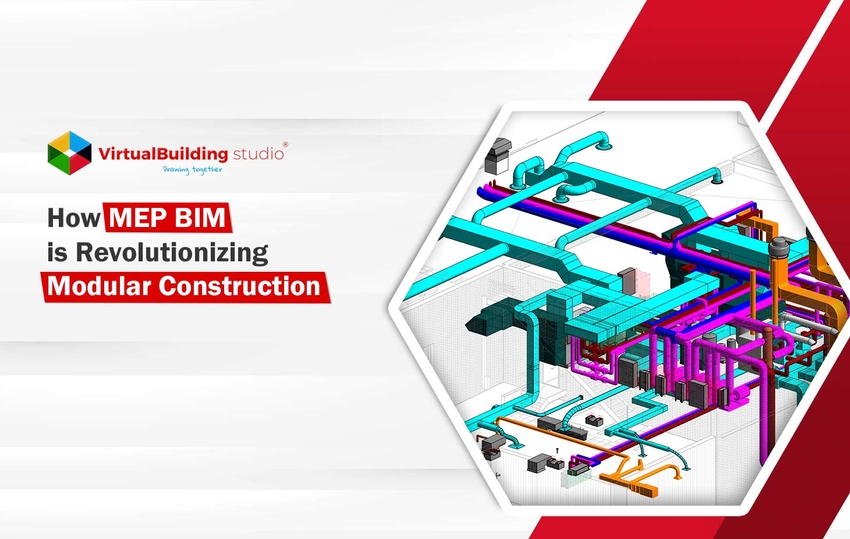
The construction industry is rapidly evolving, and modular construction is emerging as a game-changer for faster, more efficient, and sustainable building solutions. This off-site construction method involves prefabricating building components in a controlled environment and assembling them on-site, drastically reducing project timelines and minimizing waste. With its growing adoption in residential, commercial, and healthcare projects, modular construction is reshaping how buildings are designed and delivered.
However, the success of modular projects depends heavily on seamless coordination and precision planning, especially when it comes to complex building systems. This is where mechanical, electrical, plumbing, and fire protection (MEPF) BIM plays a critical role. By integrating MEPF systems into a digital 3D model, teams can detect clashes early, streamline prefabrication, and ensure flawless on-site assembly.
This article explores how MEP BIM modeling services are revolutionizing modular construction by enhancing efficiency, improving accuracy, and enabling real-time collaboration among stakeholders.
From BIM coordination services to intelligent detailing for prefabrication, BIM modeling services are driving the next phase of industrialized construction. Discover the value of MEPF BIM modeling and how BIM for Modular Construction is setting new standards in project delivery.
Understanding MEP BIM in Modular Construction
MEPF BIM modeling refers to the use of cutting-edge BIM processes to design, coordinate, and document Mechanical, Electrical, Plumbing, and Fire Protection systems in a digital 3D environment. These intelligent models integrate spatial, technical, and performance data to represent real-world systems within a building. In modular construction, where precision and coordination are critical, MEPF BIM becomes the backbone of successful project execution.
Traditional 2D CAD workflows lack the spatial intelligence and clash-detection capabilities required for off-site prefabrication. In modular builds, even minor misalignments in MEP components can cause costly rework or delay during on-site assembly.
Legacy methods also struggle to keep up with the dynamic coordination needed between architectural, structural, and MEP trades in a factory-controlled setting. BIM modeling services offer a transformative shift by enabling real-time clash detection, system routing optimization, and integration with fabrication tools.
Engineers can design MEP systems within precise module boundaries, simulate connections, and validate installations before they reach the site. With BIM coordination services, all stakeholders work from a single source of truth, ensuring prefabricated modules are fully coordinated and installation-ready.
As modular construction accelerates, MEP BIM Modeling Services provide the technical accuracy and collaboration essential to meet the demands of industrialized building delivery.
Key Benefits of MEP BIM Services for Modular Construction
Modular construction thrives on precision, speed, and efficiency - qualities that traditional project delivery methods often struggle to provide, especially when integrating complex MEP systems. MEP BIM Modeling Services bridge this gap by offering data-driven workflows that align perfectly with the demands of off-site construction.
Here’s how MEP BIM enhances modular project outcomes:
Enhanced Coordination & Clash Detection
Through BIM coordination services, all MEPF systems are modeled in a shared 3D environment, allowing early identification and resolution of clashes between HVAC, electrical conduits, piping, and structural elements. This eliminates on-site conflicts and ensures each prefabricated module integrates seamlessly during assembly.
Improved Accuracy & Reduced Rework
With MEPF BIM modeling, engineers can model systems with high precision, factoring in clearances, material specs, and real-world constraints. This minimizes design inconsistencies and greatly reduces field rework, saving time and resources during construction.
Streamlined Prefabrication & Offsite Construction
Accurate BIM models serve as fabrication-ready blueprints. Each duct, pipe, and cable tray is modeled to exact dimensions, enabling manufacturers to prefabricate modules with confidence. This supports just-in-time delivery and fast-tracked installation on site.
Cost & Time Savings
By optimizing system layouts and minimizing design errors, BIM Modeling Services contribute to significant cost and time savings. Modules are built and installed faster, with fewer material wastages and change orders, ultimately enhancing project profitability.
Better Collaboration Among Stakeholders
BIM for Modular Construction promotes integrated workflows where architects, engineers, and contractors collaborate on a centralized model. This ensures everyone is aligned with the latest design intent, reducing communication gaps and enhancing decision-making.
Applications of MEP BIM in Modular Projects
In modular construction, where precision engineering and synchronized delivery are essential, MEP BIM modeling services provide a robust digital foundation. These intelligent models go beyond visual representation to support automation, performance monitoring, and integration with emerging technologies.
Below are key applications of MEPF BIM modeling in modular projects:Design Optimization for Modular Units
Using BIM for Modular Construction, MEP systems are designed to fit within the spatial limits of modular units while maximizing functionality. BIM enables layout simulations, space utilization analysis, and early clash detection, ensuring all systems are coordinated before fabrication begins.
Automated Fabrication & Assembly
MEP models created through BIM modeling services contain fabrication-ready data that feeds directly into CNC machines and other automated tools. This supports the off-site manufacturing of ductwork, piping, and cable trays, reducing manual errors and enabling faster module assembly.
Integration with IoT & Smart Building Systems
Advanced MEPF BIM modeling allows seamless integration with sensors and smart technologies. During the design phase, BIM supports planning for IoT device placement, system connectivity, and future maintenance access, critical for modern, tech-enabled buildings.
By leveraging these applications, modular projects gain higher efficiency, scalability, and technological readiness, the key advantages in today’s fast-evolving construction landscape.
Challenges & Solutions in Adopting MEP BIM for Modular Construction
Adopting MEP BIM Modeling Services in modular construction brings clear benefits, but not without a few obstacles.
Below are some common challenges and how they can be effectively addressed:Common Challenges
- High Initial Investment: Advanced BIM software and infrastructure require substantial upfront costs, especially for small and mid-sized firms.
- Shortage of Skilled Professionals: Many firms lack in-house experts proficient in MEPF BIM Modeling, particularly those familiar with modular workflows.
“ A report by JB Knowledge says that “59% of companies state that their workforce doesn’t have the skills needed to work with BIM.” - Resistance to Process Change: Transitioning from traditional 2D workflows to integrated Revit BIM modeling services often meets internal resistance due to workflow disruption.
- Coordination Complexity: Modular projects demand precise alignment between architectural, structural, and MEP systems, which can be difficult without robust BIM expertise.
Effective Solutions
- Advanced BIM Coordination Services: Real-time clash detection, centralized models, and digital workflows reduce rework, ensure precision, and facilitate seamless modular assembly.
- Training & Technology Adoption: Structured onboarding programs and upskilling initiatives help internal teams gain proficiency in BIM for modular construction tools and practices.
- Dedicated Resource Model: Partnering with remote MEP BIM experts provides instant access to specialized talent. This model accelerates onboarding, boosts productivity, and ensures consistent project quality, without long-term overhead.
By addressing these challenges strategically, firms can fully leverage BIM coordination services and unlock the true potential of modular construction.
Conclusion
The integration of MEP BIM modeling services into modular construction is reshaping the industry, delivering unprecedented efficiency, precision, and collaboration. By leveraging MEPF BIM modeling, project teams can optimize designs, eliminate clashes before fabrication, and streamline offsite assembly, reducing waste, costs, and delays.
BIM coordination services ensure seamless integration of mechanical, electrical, plumbing, and fire protection systems, while BIM for modular construction enables smarter prefabrication and faster on-site installation.
The synergy between BIM modeling services and modular methods is undeniable. As buildings become more complex and sustainability demands grow, BIM’s data-driven approach ensures that modular projects are not only faster to construct but also higher in quality and easier to maintain.
The future will see even greater advancements, with AI-driven automation, cloud collaboration, and IoT integration further enhancing MEP BIM’s capabilities.
For firms still relying on traditional processes, now is the time to embrace and invest in MEPF BIM Modeling to stay competitive. By adopting these technologies, construction companies can unlock faster project delivery, reduced risks, and superior building performance.




